

Toxify the Brand: How a Mass Movement is Punishing a Deportation Airline
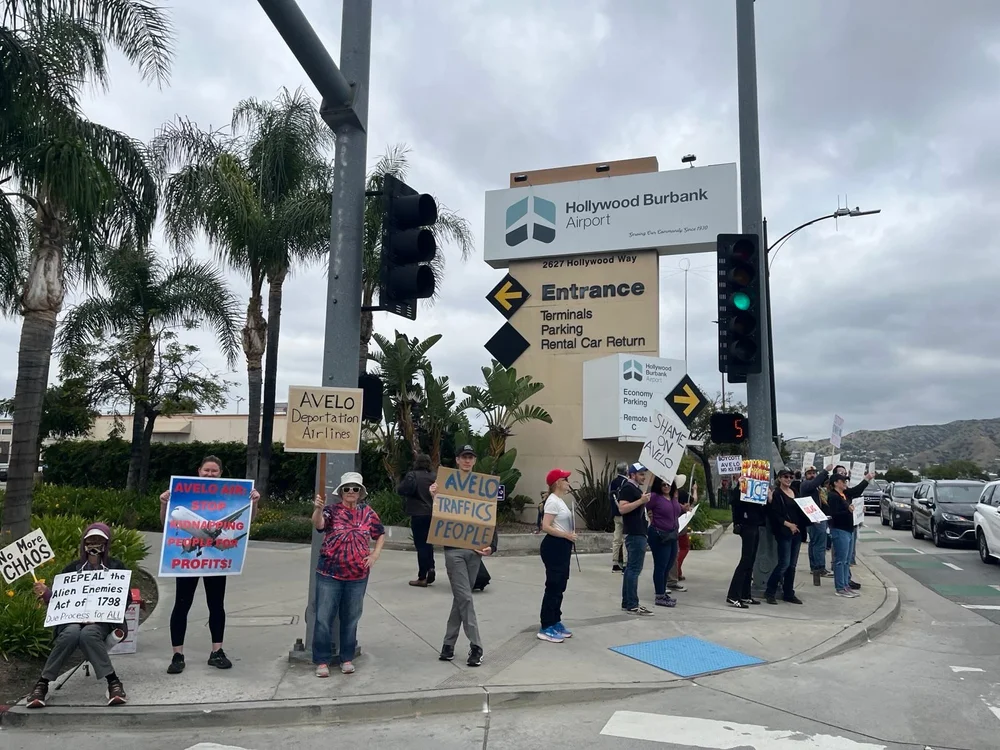
Enriching the wealthy owners of for-profit companies at public expense is central to the current administration's vast, inhumane, racist, frequently illegal, and economically reckless deportation machine. Among those receiving this federal largesse are private charter airlines, which appear to be profitably relocating individual ICE detainees up to twenty times each, all over the country, for no apparent reason other than to immiserate them and thwart their legal representation.
But in a huge victory for a national boycott campaign undertaken by multiple DSA chapters and other organizations, one ICE-sub-contracted deporter, budget flyer Avelo Airlines, is abandoning all of its normal commercial flights on the West Coast, previously a core part of its business.
Unusual Commercial Exposure
Before its contract with ICE, Avelo's prior business model had it simply selling individual commercial tickets to willing passengers in over 50 smaller, "secondary" public airports in the normal fashion. It launched service between southern California's Burbank and northern California's Santa Rosa in 2021. By contrast, other airlines colluding with "ICE Air" are little-known private charter companies like Global Crossing Airlines (aka Global X) and Eastern Air Express, which, when they aren't tormenting deportees, quietly fly sports teams and rock bands between gigs. Like extraordinarily profitable immigrant detention center operators CoreCivic and GEO Group, these entities don't exactly appeal to a broad customer base. This made Avelo a unique target.
In early April 2025, Avelo announced its ICE deportation flights would begin the following month. The backlash was immediate. The Association of Flight Attendants/Communications Worker of America called out the inhumane nature of these deportation flights, which compromise passenger safety, and stated "We cannot do our jobs in these conditions.”
In Connecticut, where Avelo had deep financial ties and reportedly 24% of its operational capacity, the New Haven Immigrants Coalition launched a Change.org petition against the airline that quickly went viral, and began protesting at Connecticut's Tweed New Haven Airport. State Attorney General William Tong expressed alarm in a letter sent to the airline, writing:
"These are flights where people—men, women and children—are shackled in handcuffs, waist chains and leg irons, where [...] people soil themselves because they are denied access to bathrooms. These are flights to dangerous jungle prisons in El Salvador and Guantanamo, where chained, bowed and shaved men are paraded before cameras for propaganda videos. These are flights flown overseas in direct defiance of court orders to return, and operated pursuant to a questionable declaration of war subject to active legal challenge. These are flights carrying terrified international students, snatched off the streets of their college towns for daring to protest. These are flights ordered by an administration that has sought to eliminate birthright citizenship—the core constitutional principle that has given me and so many others our futures in this country."
Avelo refused to confirm to AG Tong that it would comply with court orders, refrain from these human rights abuses, guarantee passenger safety and well-being, or honor birthright citizenship. "It is clear all they intend to do is take state support and make money off other people’s suffering," Tong lamented, noting that in Connecticut (as elsewhere), public funds subsidized the company's presence.
Soon after, DSA International Committee's Migrant Rights Working Group began boycott organizing, toxifying Avelo's brand, creating a useful chapter toolkit and launching a letter campaign to Avelo executives and financiers. Other early adopters of the boycott campaign included Siembra North Carolina and chapters of Indivisible and 50501 around the country.
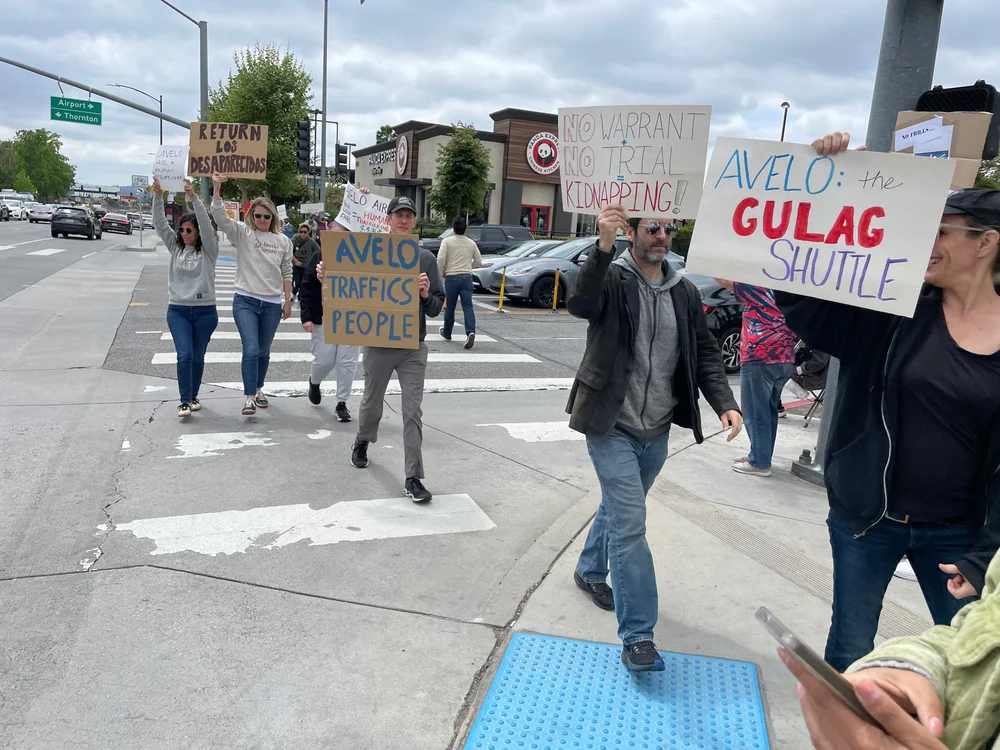
The West Coast Fights Back
Here's my (Mike’s) take on the events in Burbank:
We knew after that second asteroid strike of an election that fascism was coming to our country, but it was still a shock to see it naked and brazen in our own neighborhoods. It was in early spring, as ridiculous displays of force and cruelty rounded up dozens of our neighbors, when DSA-LA members like me first heard about Avelo's ICE contract. Hollywood Burbank Airport was Avelo's largest West Coast hub. Burbank is a progressive, artsy town full of union stagehands and animators. Like everywhere else cool in America, it has become prohibitively expensive and has produced a robust community of tenant activists in response. It was in a Signal thread on this topic that I pitched my fellow activists, “Y’all, we have to protest against the fascist airline in our backyard.” Three other angry Burbankers agreed with me and we picked the following week for an action at the airport, putting out a general call to the community to stand against a company trying to profit from human rights abuses. We expected a modest turnout.
On April 18, well over a hundred people came out to the Burbank Airport on a Friday at noon, in the middle of the workday. Local elected officials, DSA-endorsed candidates for office (I’m proud to have been one!) and activists from a half dozen local organizations turned out. We got a constant stream of honks and support to about six middle fingers per hour. Somebody mentioned that we should do it again, so we made it a biweekly protest for Friday at noon. Another community group started an entirely separate regular protest on the weekends; both protests had substantial community attendance. And so it went for months, hammering Avelo, while across town another boycott took on Tesla and Elon Musk. We had a clear demand made against a clear antagonist – cancel the ICE contract or get the hell out of our town.
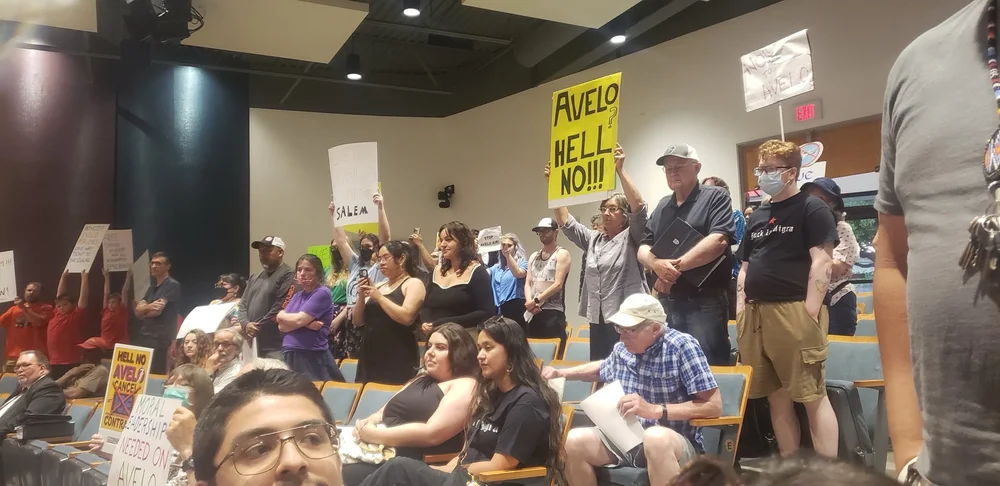
Salem DSA held a series of well-attended public events, pushing for divestment from deportation airline Avelo. Photo, Salem DSA / Jordan M.
Meanwhile, following Santa Rosa airport protests by Sonoma DSAers and others, Avelo suddenly announced on May 1 it was ending service there. And in Oregon's capital city, Salem DSA's Labor Working Group developed its own boycott pressure campaign, holding four well-attended public rallies at the airport and town hall, as well as a petition and letter-writing campaign.
Back in Burbank in June, we watched ICE hurriedly shuttle more victims across the tarmac and onto unmarked charter flights. Protests at federal facilities provoked an absurd and violent overreaction from the LAPD on June 8 (you may have seen the five torched Waymos), and LAPD shot some reporters in the back with “less lethal” munitions that are designed and mandated to be fired at the ground. I helped provide first aid to a man who was shot with a tear gas canister at point blank range while he committed the supposedly threatening act of pulling to their feet someone who had fallen.
We deserve real justice for these sickening abuses of force, and we certainly deserve justice for the state-sponsored terrorism hiding behind masks, Oakley sunglasses and government-issue rifles, but such justice is some distance away. Avelo Airlines, in contrast, was right there. So we kept protesting.
Surprise From Behind the Redwood Curtain
California Redwood Coast Humboldt County Airport (ACV) is a small commercial airport notable for its fog, lush and verdant scenery, and alternative to driving three to five hours on winding rural roads to get to a city larger than the Eureka/Arcata "metropolitan" area, population roughly 40,000. Only Avelo and United offer flights here.
Humboldt DSA was still a tiny pre-Organizing Committee, and had never even held a public meeting or tabled at an event, when our anger at the southern California ICE abuses prompted us to vote on June 13 to join the Boycott Avelo campaign as our very first...anything. Part of our reasoning was strategic: we were meeting in a sanctuary city in a sanctuary county in a sanctuary state, so surely here of all places we could find some foothold on the issue? And another part was practical: the toolkit, training and friendly coaching from the International Committee's Migrant Rights Working Group were resources we needed to learn how to do DSA pressure campaigns.
Local DSAer G. Mario Fernandez, a Eureka city councilmember, confirmed that a couple thousand dollars in city funds had recently gone to Avelo tickets for staff travel. Along with other locals, including the more established Humboldt Democracy Connections (HDC), Humboldt DSA began pressuring the council to join the boycott. We contacted them as concerned voters, spread the word personally, online, and while tabling at local events, and wrote an organizational letter to the city council that was picked up and published on July 7 by a local news blog, prompting additional local media coverage.
The next night, on July 8, we waited for hours at a Eureka City Council meeting alongside HDC members until public comment was called on Item I.2, "Use of Avelo Airline". All nerves, uncertainty, and moral clarity, 8 DSA members and soon-to-be members provided half the public comment that night.
Even though the city attorney had expressed liability concerns about the city council voting to join the boycott, after hearing from all of us, Councilmember Fernandez put forward a motion to "Discontinue use of Avelo as a vendor until such time that they are no longer in contract with the Department of Homeland Security to operate deportation [flights]." Then we watched in amazement as councilmember after councilmember publicly declared their disgust at the grotesqueries of the current administration's deportation policies. They ultimately voted 5-0 to pass the motion.
The City of Eureka had just become the first public jurisdiction in the country to join the boycott.
Avelo’s West Coast Retreat
Less than a week later, Avelo announced it would be withdrawing from Humboldt, and ultimately all of its West Coast service by early December. This meant not only Humboldt County and Burbank, but Salem, Eugene, and Medford in Oregon; Pasco and Redmond in Washington; Las Vegas, Nevada; and Kalispell, Montana. After all the public investment in the company by many of these places, Avelo was taking the money and running, as it had done before.
While the company would only attribute its decision to vague economic factors, multiple news outlets connected it to the boycott. One industry publication called it "a major strategic shift away from a geography that has comprised a significant share of its flying". On July 17, its competitor Breeze Airways, under a "Seriously Nice" slogan, announced it would be adding service to Humboldt and several other locales just abandoned by Avelo.
These events galvanized the boycott movement elsewhere. After a relentless campaign where it all began, the City of New Haven finally joined the boycott July 28, prohibiting staff from spending public funds on Avelo tickets or marketing. Its mayor noted, "Travel should be about bringing people together, not tearing families apart." Avelo then dropped service it had only begun providing between New Haven and Portland, Maine three months before.
At DSA's August Convention in Chicago, thirty chapters attended the Boycott Avelo Summit. The work continues all over the country. Marilia M., co-chair of DSA IC's International Migrant Rights Working Group notes:
I've felt really energized by the DSA members leading the Avelo Boycott in their chapters. People are getting really creative with the tactics they are experimenting with. It feels really good to be engaged in a campaign that has a clear path to victory, even if it's only a small win in the bigger picture of dismantling the ICE apparatus. It'll be all of the small victories together that ultimately take down the machinery that profits from the detention of our communities.
On September 17, over sixty DSAers working on chapter communications nationwide attended a communications training focused on the Avelo boycott. An additional victory came the next day when, after continued pressure, on September 18, Humboldt County residents learned Avelo was withdrawing even sooner than previously announced, effective October 20. On September 30, a power mapping workshop will further equip chapters working on the boycott.
As the movement grows within DSA, it is complemented by The Coalition to Stop Avelo, groundavelo.org, groundice.org (which targets aviation fuel providers), and Who's Profiting from ICE, which identifies other deportation machine companies.
We are too rarely afforded opportunities in life for triumph. When it happens, we must savor it so we can draw strength and determination when we face inevitable setbacks. We earned this West Coast victory together, and so shall we earn the next, and the next, and the next.


Labor Day: Starting to build
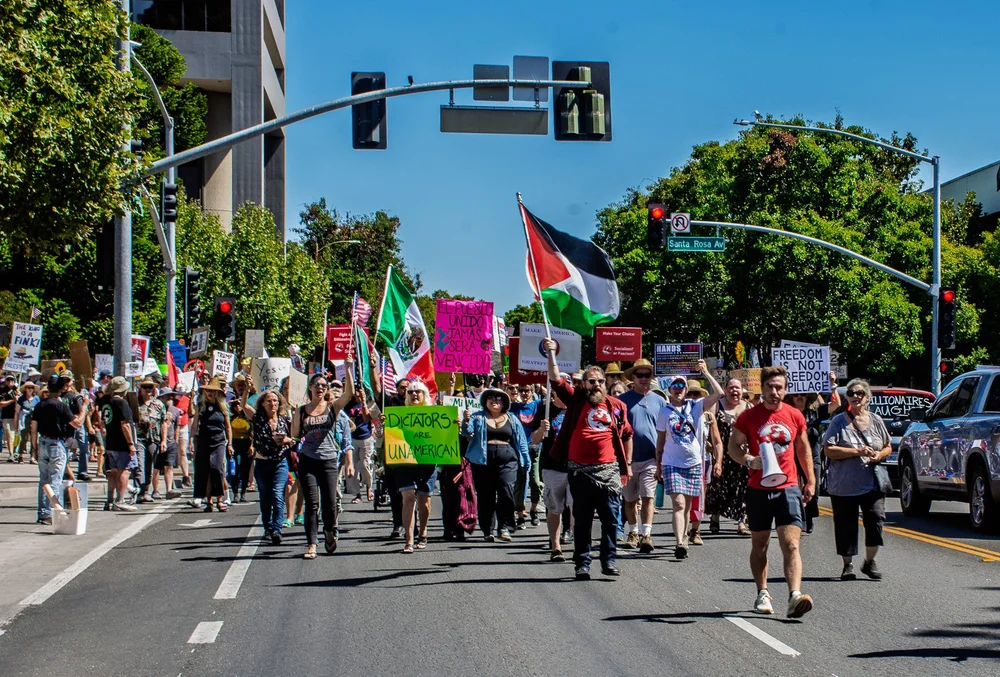
Rising to the occasion behind the class conscious slogan, “Workers Over Billionaires”, an estimated half million people across the country transformed what has usually been, in recent times, relatively sparse and insular Labor Day picnics and breakfasts, into robust public manifestations of displeasure with the fascist Trump regime. Marches and demonstrations on September 1 kept the momentum going for mass action following the “No Kings” events of earlier in the summer.
While the numbers did not measure up to the size of the biggest earlier protests, which claimed millions of people in the streets, half a million on short notice, in an event held during the last vacation weekend of summer, is nothing to sneeze at.
Although most unions and labor councils waited until a week or two prior to the holiday to put out the word—reflecting perhaps labor leadership hesitancy due to fears of pro-Trump sentiments within the ranks of some unions—the level of participation should encourage bolder thinking going forward.
Development of the mass demonstration muscle—a tactic too long neglected by the American labor movement—is now underway. Continuous exercise of this tactic will be critical in building toward the May 1, 2028 general strike called for by United Auto Workers president Shawn Fain, and a key element in bringing together a broad antifascist movement.
DSA members across the state also answered the call. Here are snapshots from a few chapters of how our members organized to make Labor Day worthy of the name. [The reports have been lightly edited for clarity.]

The Sonoma march led through a mall.
Sonoma
Reported by Cameron Kaiser: “We hosted a rally and march of around 500 people in the Santa Rosa Courthouse Square under the theme of Workers Over Billionaires. We invited organizations like the Working Family Party, Sonoma County Green Party, and the American Party of Labor to come give speeches alongside us.
“With a wide range of progressive parties, two themes among the speeches were clear: the system has failed the working class, and we are all united in our resistance against fascism and in the fight for the rights of the people. We then marched through the Santa Rosa mall, shouting chants like "El pueblo unido, jamas sera vencido", "No justice, no peace", "Si se puede", and "No trump, no KKK, no fascist USA".
“Upon our return to the square, we concluded with more speeches and finally a call to visit the tables of all the organizations present and engage with the movement.”

Tim MacKenzie spoke on behalf of Silicon Valley DSA in San Jose’s rally.
San Jose
Reported by Tim MacKenzie: “There were two events in our territory on Labor Day. One was a planned 'human chain' protest with 17,000 people from Redwood City to Santa Clara on El Camino Real. I showed up for about an hour and talked with a few people in Mountain View. I used the opportunity to bring up Measure A which our chapter endorsed to save County hospitals, and Prop 50, endorsed by California DSA. You can see some local reporting here.
“We turned out as a chapter for the Labor Day event in San Jose. I wasn't involved in planning, but one of our Labor Working Group co-chairs came to a planning meeting the week beforehand. It came together relatively quickly and was started under the auspices of the May Day coalition we had been part of earlier in the year. The South Bay Labor Council endorsed and had a speaker. There were a few hundred people. It was smaller than earlier 50501 mobilizations in the summer, but still decent turnout.
“About a dozen chapter members came out, and half of us met beforehand at our office in downtown San Jose a few blocks from City Hall where the protest happened. We got our flag and banner and clipboards with sign up sheets and folded some zines together before walking over.
“Representatives of a dozen unions and community organizations spoke at the rally. I went last representing DSA. Here’s what I said.”
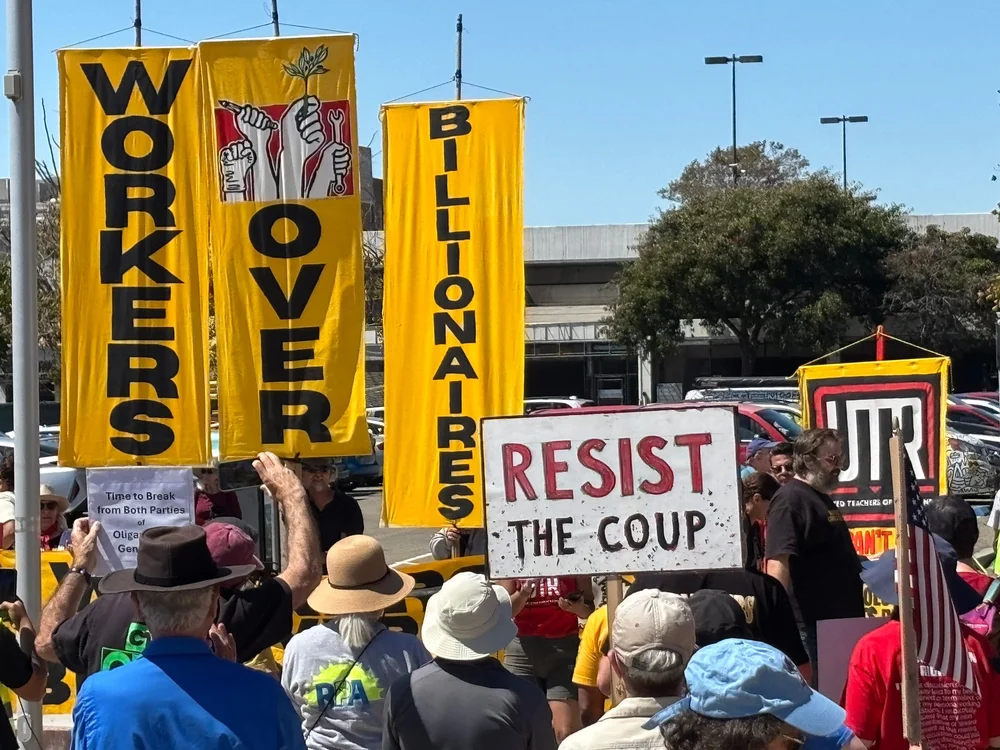
David Solnit’s artwork graced the Richmond rally.
Richmond
Reported by Fred Glass: “East Bay DSA faced a choice of several events, and endorsed a rally and brief march held in Richmond, a former industrial town of 100,000 north of Berkeley. Coalition partners included the Richmond Progressive Alliance, which holds a majority on the city council; United Teachers of Richmond; SEIU Local 1021; and the Contra Costa Labor Council, among others.
“Each of these organizations sent speakers to the mic at the rally in front of the Frank Hagel Federal Building, and the crowd of several hundred responded enthusiastically to the skewering of billionaires, fascists, ICE, and Chevron, along with various other plagues afflicting the working class of Richmond and the country.
“Councilmember Claudia Jimenez, a DSA member, reminded the crowd to cheers about last year’s impressive victory over Chevron, whose refinery looms over Richmond and has for a century treated it as a company town. Fearful that a proposed ballot measure would have caused it to cough up a dollar per barrel of oil refined, the corporation agreed to pay the city $550 million over ten years to withdraw the initiative, providing critical funding for city services. But the biggest applause came for a couple of Richmond High School students, who, like their teachers, spoke movingly of the need for adequate resources to enable public education to lift them up.
“Following the rally the crowd gathered itself for a short march around the downtown area.”
Next up for mass demonstrations: No Kings Day on October 18.


Socialists Can’t Sit Out the Prop 50 campaign

On the national stage, Republicans are moving to secure minoritarian rule through redistricting efforts in Texas and Missouri. Through this anti-democratic effort, Republicans are poised to pick up six seats in Congress. This November, Californians have the opportunity to challenge these power grabs by passing Prop 50. If passed, the ballot measure will redraw five Republican-held congressional districts in California (CA-1, CA-3, CA-22, CA-41, and CA-48), making them more competitive and friendly to a potential DSA challenger.
Failing to redistrict in California while Republicans redistrict in Texas will cement Republican minoritarian rule in Congress for the foreseeable future and provide a blank check to the Trump administration to continue carrying out their violent and extremist policies. Further, it is likely the 2030 census and subsequent redistricting will heavily favor Republicans in the electoral college through 2040.
Socialists can’t sit this one out! As a national organization, we have a mandate to run five congressional candidates in 2028. Prop 50’s new map further opens the door for DSA challengers in the 2028 cycle. One of these five must come from the West Coast. California has been hit hard by the Trump administration through ICE raids, defunding of social programs, and attacks on healthcare and trans folks. The Golden State is a destination for people seeking a better life. It has been misrepresented by status quo Democratic Party machine politicians who seek only to secure their own power and wealth. We need a 2028 candidate who can fight the fascist right and fully expose the contradictions of the inept Democratic Party apparatus.
California DSA and chapters endorse Prop 50
On August 23rd, California DSA voted to endorse Prop 50 and create a statewide working group charged with building a DSA canvassing and comms program around the initiative. California DSA will also bottomline a statewide public webinar providing a socialist analysis of why we have arrived at this political moment and how we can emerge from it, and coordinate a DSA Day of Action for participating chapters.
Chapters across the state are throwing down to get Prop 50 passed. Sonoma endorsed Prop 50 on August 25th and is currently looking into doing joint canvasses with their local Working Families Party (WFP). DSA-LA just endorsed the measure locally by majority vote at their September chapter meeting, and has electoral working groups spinning up for the 2026 cycle that can use this as an early exercise. San Diego and Silicon Valley DSA are also exploring endorsement at their upcoming chapter meetings this weekend. Pending endorsement, San Diego DSA is tentatively planning ten canvasses with a target of 2000 doors knocked before election day.
We are only six weeks away from election day, so this will be a relatively short campaign. Aside from passing Prop 50, the primary objective of the CA DSA Prop 50 campaign is to recruit our neighbors to DSA and strengthen our field programs.
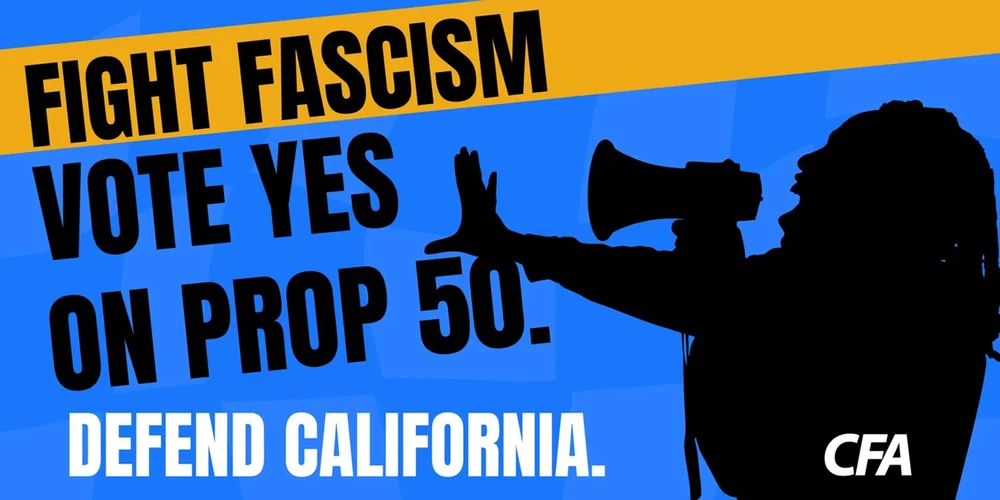
Labor is all in for Prop 50, on the November ballot.
Fascist threat
This ballot initiative is a vehicle to have organizing conversations in our communities about the threat that the fascist right poses to multiracial democracy. As democratic socialists, we want an economy that is democratically controlled by working people and we run candidates who work to advance tenant protections, immigration justice, and the power of organized labor.
Redistricting is a defensive tactic, and while it will reduce Republican expansion if passed, this measure alone is radically insufficient to respond to the aggregate moment. To respond at scale, we need to organize. This six-week effort gives us an opportunity to ask people to get involved in campaigns that will help involve them as agents in building collective power. DSA members can motivate folks at the doors to not only vote yes on Prop 50, but engage in a longer-term strategy to combat the right by joining DSA.
To join the CA DSA working group, fill out this interest form: https://actionnetwork.org/forms/california-redistricting-working-group-interest-form/


Against the CA DSA Prop 50 Endorsement
California DSA has recently voted in favor of supporting Proposition 50, a proposal to redraw California’s districts that is self-evidently aimed at creating enduring structural Democrat electoral supremacy in California, in the form of creating and sending materials to chapters throughout the state, and encouraging these chapters to quickly launch campaigns over the next seven weeks. We dissent from this endorsement and reject its strategy, and lay out a rebuttal to the argument for endorsement.
What Does DSA Really Stand To Gain from Prop 50?
In the piece laying out the argument for the endorsement, CA DSA and Groundwork caucus member Chris K. called Republican gerrymandering in Texas a “calculated assault on democracy” and “the Right’s most powerful weapon for locking working people out of politics.” While he claims to have “no illusions about the party establishment and what it wants out of this,” he argues that gerrymandering can be used in California as a counterweight to Republican gerrymandering elsewhere in the US, especially in Texas. This illustrates the defining political mistake of the DSA Right: mistaking the goals of the Democratic Party for the goals of DSA.
Prop 50 makes perfect sense from the Democrats’ perspective. Of course Democrats want to minimize Republican footholds and shape the American political map in ways that maximize the electoral power of their (shrinking & demoralized) base. To lend our endorsement to a measure designed in their party’s interest, not ours, is to sacrifice our independence and organizing efforts without gaining any leverage.
Indeed, if we truly have “no illusions” about what this is, then we must admit it is very likely that Governor Gavin Newsom will use this redistricting process to engineer mid-layer support for his 2028 presidential campaign. Prop 50 provides him and his allies with another mechanism for consolidating their networks of patronage, rewarding loyalists, and structuring the political field to his benefit. Why align with that now unless we aim to be junior partners in the Democrat presidential campaign in 2028? As most recently shown in Minneapolis, it is an error to assume that the Democrat party will not strike against us as soon as we pose a threat to their capitalist base.
In his piece, Chris K. says “this moment gives us a chance to both take a realpolitik move to reduce the GOP advantage from Texas gerrymandering and to agitate and push beyond the rigged two-party system,” but we can’t be simultaneously agitating against a rigged two-party system while supporting one of the parties rigging it. Chris also suggests that we demand more fundamental reforms in CA such as proportional representation, which gerrymandering is designed to decrease. The confusion of the author’s politics illustrates the contradictions in our endorsement, and those contradictions will not be lost on the working class of California.
But let’s also be clear on what we’re advocating for: if the DSA wants to credibly demand an expanded democracy, our demand cannot be for “fair” electoral maps under capitalism, an idea which itself is based on liberal assumptions of political rights. It must be for a new kind of political system entirely—one in which workers control their workplaces, communities, and governments directly, not one in which capitalists shuffle district lines to their advantage.
How Our Experience in the Central Valley Shapes Our Position
North Central Valley DSA (NCVDSA), a small chapter which organizes in four counties throughout rural California, has experienced steady growth since 2022, and it owes its growth to working class Californians who reject partisan divides in favor of class war. The palpable disdain for both Democrats and Republicans can be seen both within and beyond the electoral context, and there is a critical demand among rural Central Valley workers for an alternative to the capitalist two-party system. In 2024, dozens of NCVDSA members participated in the CA DSA ARCH campaign, canvassing voters who spoke of the hardships they’ve faced for generations; astronomical rent increases, abandoned public transportation projects, extreme land subsidence, unbearable drought, unbreathable air. These attacks on Central Californians are often bipartisan, conducted by politicians who switch-hit between D and R on a whim. Many NCVDSA ARCHers felt like we were fighting on two fronts: convincing our neighbors that, while not a panacea, these propositions would be an important tool to help the working class, while at the same time convincing them that we were not sent by the Democrats, which would have instantly lost us credibility.
If we support Prop 50, we will set back our own work throughout California towards showing up as an alternative to the capitalist two-party system. Rejecting Prop 50 does not mean ignoring the real frustrations people feel about Republican gerrymandering. On the contrary, it is an opportunity to connect those frustrations to a broader critique of capitalist politics. We can explain to workers why both Democrats and Republicans manipulate district lines, why neither party is truly invested in their empowerment, and why only socialist politics can deliver real democracy.
California DSA’s Fundamental Political Error: Identifying the Democrats’ Goals with DSA’s Goals
Broadly, we understand CA DSA to be operating on the notion that the current primary contradiction in the United States is Trumpism, and the primary task before us as DSA is to stymie Trump. But we cannot take such a myopic view of the struggle between capital and the people: Democratic capital cannot save us from Republican capital and we cannot organize the working class through building the personal brand of Gavin Newsom. Our organizing work throughout California’s East Bay and Central Valley regions has made it clear to us that DSA must win the support of the working class regardless of party affiliation or lack thereof.
The mission of DSA as an organization is not to push the Democrats into action to defeat the Republican Party. Our class enemies are just as powerful within the Democratic network as on the Republican side, and losing sight of class antagonisms is a huge political error. Our mission is instead to organize the broad working class and win political power on their behalf. It is not possible to achieve this goal by playing by partisan rules, and only appealing to those members of the working class who are already committed to voting for Democrats.
Last year, only 34% of California’s eligible voters voted for the Democratic presidential candidate. If we aim for a strategy that alienates the near supermajority – 66% – of eligible voters who didn’t vote Democrat, then we will forever limit our horizon to being a minor advocacy group in the Democrat sphere. It’s our responsibility as scientific socialists to assess our terrain more clearly if we want to create a better world. DSA chapters in California and throughout the country are learning how to organize folks who do not vote Democrat, and supporting Prop 50 would present a significant setback to this work.
What Would Organizing the Broad Working Class Look Like?
Imagine, instead of endorsing Prop 50, the DSA aimed at agitating along class lines, communicating simply and clearly that both Democrats and Republicans are rigging the electoral system and disregarding their working-class base. We could point out how working-class communities of color, immigrant neighborhoods, and rural towns alike are carved up by politicians. We could argue that true representation will never be achieved through bourgeois redistricting, but through building worker power independent of both capitalist parties. We could use this moment not to strengthen the Democrat hegemony in California, but to destabilize it, and to create openings for DSA to win.
The Democratic party is the weakest it's been in our lifetimes. The working class correctly views the Democrats as failing to fight back against Trump in any meaningful way, but simply fighting Trump to gain electoral ground without actually addressing the demands of the working class will not resolve the heightening contradictions in this country’s politics. We reject the idea that aligning with the Democrats’ belated attempt to win back some of its loyalists will do anything other than undermine DSA’s principles and ideological independence, and we strongly urge California DSA to reconsider its endorsement. California chapters across the state understand that DSA must grow, develop, and thrive at the expense of the Democratic party, and we may be forced to reassess our continued support of a state organization that increasingly works against the goal of creating an independent socialist party.


Rebuttal to Andrew T and Ian H’s brief against California DSA’s Prop 50 support
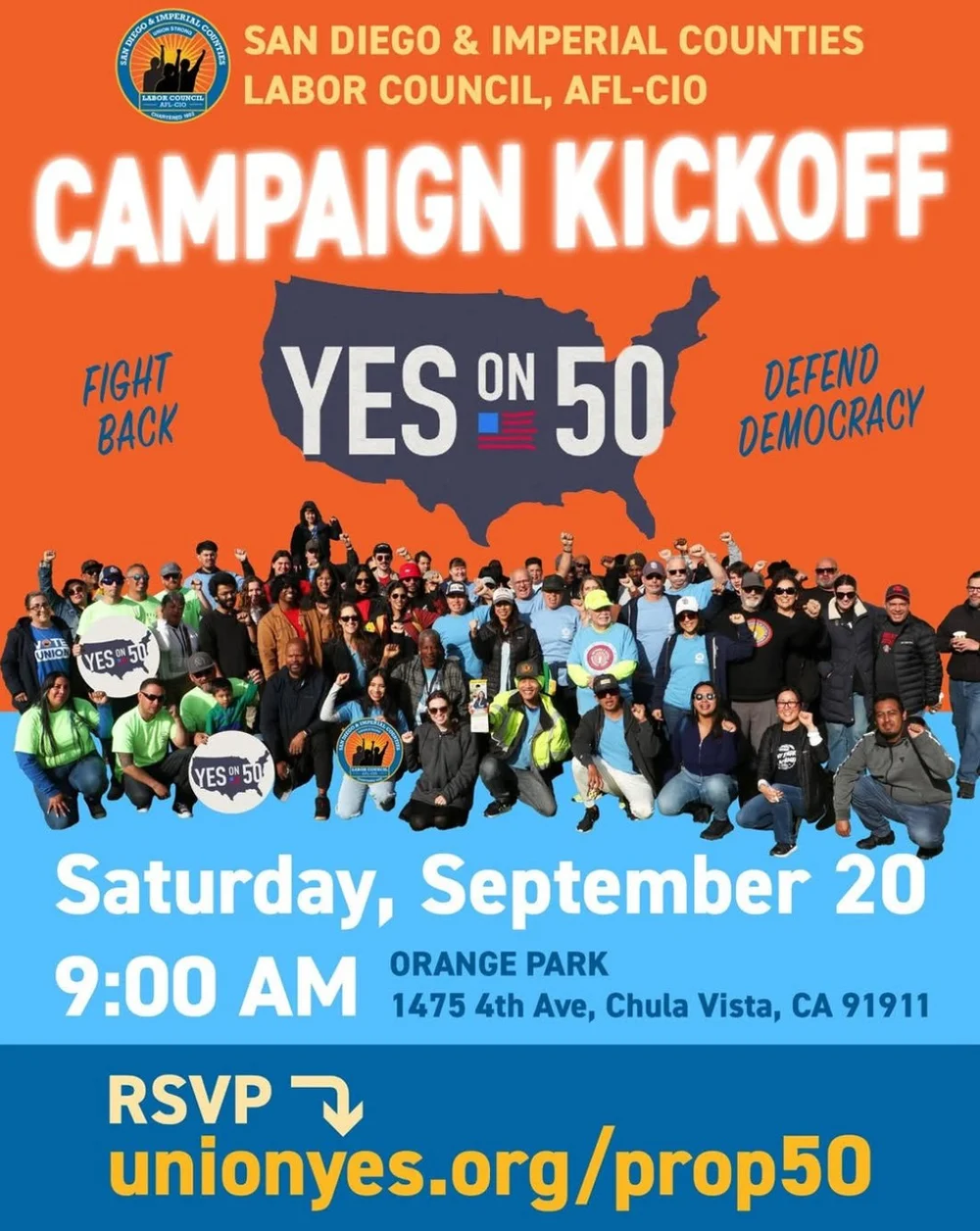
Andrew T and Ian H’s argument (“Against the California DSA Endorsement of Prop 50”) showcases their disdain for our bedfellows in the campaign, particularly Governor Gavin Newsom and the Democratic Party: “To lend our endorsement to a measure designed in their party’s interest, not ours, is to sacrifice our independence and organizing efforts without gaining any leverage.” I don’t know about you, but I’m not fond of Gavin Newsom or the neoliberal wing of the DP. In this way we’re all on the same page. But understanding where and why we disagree requires a much bigger picture than T & H draw for us.
Let’s talk about bedfellows. In making their arguments against Prop 50 they line up with right wing billionaire Charlie Munger—who has spent tens of millions of dollars in California elections opposing progressive tax measures while supporting union-busting initiatives. Munger, in a New York Times op ed, acknowledges the Texas redistricting measure that gives five more Congressional seats to the Republicans is wrong. But his weak argument is that two wrongs don’t make a right, ignoring the likely outcome: Republicans will stay in control of the House of Representatives. Of course he ignores that: it’s his desired outcome—a far right billionaire who wants to keep other far right billionaires in charge. Also on the anti-50 side: the California Republican Party and former Republican Governor Arnold Schwarzenegger, who makes a similarly limp argument that gerrymandering is wrong anywhere and everywhere.
No abstract morality, please
In other words, Munger, Schwarzenegger and Republican leadership make an abstract moral argument against Prop 50, masking their real motivations: their support for the consequences of Prop 50 going down to defeat, which are concrete and political and just fine with them.
T & H tell us that California DSA is mistaken in its support for a measure that aims to offset Trump’s dangerous gerrymandering chess move in Texas. As socialists of course they offer different reasons for their position than the billionaires do. But the level of abstraction that they offer here is pretty much on the same plane. I’ll address three problems with their opposition to Prop 50.
The problem is fascism
Nowhere in the article’s 1400 words do the authors utter the word “fascism”. This is its central flaw. All the rhetoric about building socialism by winning over the broad working class, and polemicizing against working with the class-betraying Democratic Party, etc., misses a key concept: fascism is far worse for the working class—day to day, and in the long run—than a society that retains basic democratic rights. It’s the slide into fascism that’s at stake here. On this the authors have nothing to say.
T & H want to
…be clear on what we’re advocating for: if the DSA wants to credibly demand an expanded democracy, our demand cannot be for “fair” electoral maps under capitalism, an idea which itself is based on liberal assumptions of political rights. It must be for a new kind of political system entirely—one in which workers control their workplaces, communities, and governments directly, not one in which capitalists shuffle district lines to their advantage.
Well, OK, comrades, we’re with you there. We just fail to understand how greasing the skids to fascism now accomplishes anything on the road to socialism in the future. Please spare us the obvious: yes, it’s a capitalist society, and the Republicans and Democrats are the twin parties of capital. The Democrats are no friend of the working class, etc. We are well aware of all that. That’s not what this is about.
These arguments read like a Maoist screed from the 1970s. In that unfortunate decade, competing left grouplets promoted slight variants on a rigid belief in their party line combined with hallucinatory expectations for revolution around the corner. This deadly combination delivered irrelevance for this section of the left in regard to actual working class struggles and ultimately brought about the implosion of the Maoist left. (If you are unaware of these events and the parallel danger now, read Max Elbaum’s Revolution in the Air.) Making this mistake today—arguing for revolution in the abstract, while stepping aside from the opportunity to block fascism and build alliances with progressive forces (and no, I’m not talking about Newsom or neoliberal Dems) is inexcusable, given that the history is available for anyone to know, should they care to.
Hidden accelerationism?
Perhaps there’s a hidden accelerationist view at work here—the belief that the worse things get, the better for the revolution. Since presumably we’re all historical materialists, let’s look at the evidence in history. In no advanced capitalist country has this ever worked out. The closest the argument comes to such a picture in the United States is the Great Depression, which eventuated in the rise of the industrial unions and the social democratic gains for the working class of the New Deal—not revolution. This occurred on the back of the strongest labor movement the country has seen.
At the moment we simply don’t have a labor movement like that, or anything like the balance of forces to bring about a contemporary equivalent of even this important but relatively modest advance for the working class. And no clear way to get there—unless it’s the anti-fascist movement that is cohering slowly around us. Prop 50, which may well carry all the neoliberal baggage T & H claim, is nonetheless one of the tools in that movement.
Andrew T and Ian H say, “The confusion of the author’s politics illustrates the contradictions in our endorsement, and those contradictions will not be lost on the working class of California.”
Contrary to the authors assertions, it’s improbable that “the working class” will put DSA under a microscope and stand in judgment of our actions anytime soon. That class conscious, for-itself working class has yet to construct itself, and steps in that direction are more likely to be earned by an anti-fascist movement utilizing every reasonable tool at its disposal, including Prop 50, than by proclaiming moral purity and standing off to the side of the battle.

Where’s the labor movement?
That’s because there is another word missing from their argument: labor. It is DSA policy, and a categorical belief of most DSA members, that we stand shoulder to shoulder with unions in their struggles. We don’t do so uncritically. We enter into coalition work with eyes wide open, understanding the often rightward drag of labor leadership as well as the passivity of the rank and file in too many unions. Nonetheless organized labor remains the central tool at the disposal of the working class. Like any tool it may be used well, badly or not at all. For Ian H and Andrew T apparently the favored choice is “not at all”.
The California labor movement is all in on Prop 50. It knows that with a Congress rubberstamping Trump’s anti-labor agenda (destruction of federal workers’ collective bargaining rights, stacking the National Labor Relations Board with anti-union administrators and staff, etc.) conditions for the working class will only grow more dire. Prop 50 is a unifying campaign for labor action between now and November. That provides socialists the opportunity to work together and engage in constructive dialog with union activists as the campaign unfolds; to build mutual respect between union activists and DSA members; and ultimately, between unions and DSA—an opportunity unavailable to those abstaining from the struggle.
What is the alternative to Prop 50 offered by Andrew T and Ian H? Their example is the organizing work done in the central valley by one of our chapters in 2024, which they describe as conducted by “dozens” of comrades during the ARCH campaign for housing propositions 33 and 5. The comrades canvassed working class voters and learned that a) they have big problems, caused by capitalism and b) they don’t like the Democrats. The chapter has grown, they say, because working class Californians “reject partisan divides in favor of class war”. With all due respect to the hard work of canvassing in working class neighborhoods, California’s central valley contains seven million people, and the growth of a local DSA chapter by “dozens” doesn’t quite get to the scale of what we are facing, nor does it allow for generalizations about what “the working class” wants or doesn’t want. Again, our analysis should be concrete, not abstract.
The outcome of Prop 50, if it prevails in November, will be to possibly prevent the Republicans from stealing the 2026 congressional elections by redrawing districts in Texas. There’s no guarantee that that will end the matter; other factors will be in play. But without Prop 50 the fascist Republican Party will more than likely stay in control of Congress. Don’t like neoliberal Dems? Neither do I. Don’t like progressive tax-averse Governor Newsom? Neither do I. Don’t like gerrymandering? Me neither. I’m voting and working for Prop 50 because I like fascism even less.
Finally, T & H are factually wrong about Prop 50’s content, which, they assert, is “self-evidently aimed at creating enduring structural Democrat electoral supremacy in California”. Well, no, it expires in 2030. It is a temporary tactic (not a “strategy” as T & H would have it) to forestall a manipulated outcome on behalf of fascism while Trump is in power. T & H’s arguments are wrong on fact, wrong on the way forward. Please follow the lead of California DSA’s State Council and support Prop 50.


Kelly Latimore | Iconography as Resistance


A Weapon of Annihilation Flies Over Montpelier
Note: posts by individual GMDSA members do not necessarily reflect the views of the broader membership or of its leadership and should not be regarded as official statements by the chapter.
GMDSA Co-Chair Joe Moore on the recent B-2 flyover. Photo Credit: Northrop Grumman/U.S. Air Force
On the afternoon of Saturday, September 20, a B-2 “Spirit” stealth bomber flew low over Montpelier on its way to Norwich University. The 2 p.m. flyover was scheduled to coincide with the kickoff of Norwich’s homecoming football game.
The B-2 is a heavy bomber designed to carry a large payload, including up to sixteen 2,400 pound B83 nuclear weapons - each one with a potential yield 80 times that of the Hiroshima bomb. At about $2 billion per plane, the B-2 is the most expensive military aircraft ever produced. In terms of both cost and destructive capacity, the F-35 pales in comparison.
I happened to be standing in the parking lot behind Montpelier’s Christ Episcopal Church when I heard the low roar of the B-2 overhead. It was a terrifying sight to behold from directly below. Its unique angular profile makes it immediately recognizable as a nuclear-capable stealth bomber. With only 19 in existence, the B-2 is a rare sight in most places, not to mention the skies over Vermont’s capital.
A deep sense of unease at finding myself directly below a weapon of mass annihilation quickly turned to anger. At that moment, I was surrounded by the tents and canopies of Montpelier’s unhoused population. Dozens of Vermonters were forced to seek refuge in the Church parking lot following the end of the state's motel housing program on July 1 and Montpelier City Council’s ongoing ban on camping in “high sensitivity areas.” The juxtaposition of the $2 billion B-2 flying low over a cluster of makeshift shelters erected on parking lot asphalt could not have been more stark.
This one plane alone could have paid for the construction of 10-20,000 additional units of housing – not to mention clinics, schools, childcare centers, and other socially useful infrastructure. At $2 billion, one B-2 represents just under one-quarter of Vermont’s entire state budget. Its presence in the skies over our communities is both an affront and a timely reminder that the existence of poverty and homelessness in America – the wealthiest county in the history of the world – is not an inevitability. It is a social choice.
While gratuitous displays of military power have become commonplace at U.S. sporting events, we should remember that those machines that inspire feelings of awe and pride in many Americans are weapons of mass destruction that inspire terror in most other places around the world. For the thousands of refugee families who have resettled in Vermont after fleeing wars abroad – including U.S.-launched wars – low-flying bombers are not associated with patriotic pageantry. They are associated with death and devastation.
Norwich University is a private military college, but its leaders should consider its responsibility to the community and region in which it is embedded. Football is enjoyable on its own. The University doesn’t need to subject Washington County residents to the presence of weapons of annihilation for the purpose of “entertainment”.
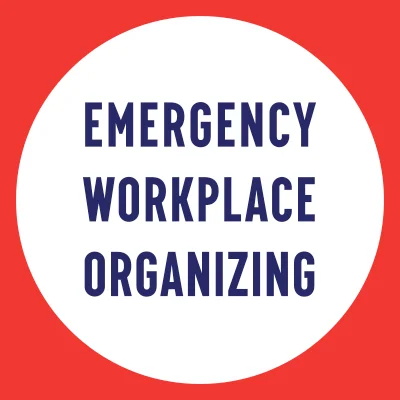

Chicago labor’s fight against child slavery in Côte d’Ivoire
The Brach’s factory closure hit working families in Chicago. To fight back, these families took the struggle from the shop floor and made it international.
The post Chicago labor’s fight against child slavery in Côte d’Ivoire appeared first on EWOC.


Fighting apathy and algorithms
We don’t have to do this alone. We don’t have to FEEL alone. Socialize and organize because we’re in this together, fighting for a better world!
The post Fighting apathy and algorithms appeared first on EWOC.
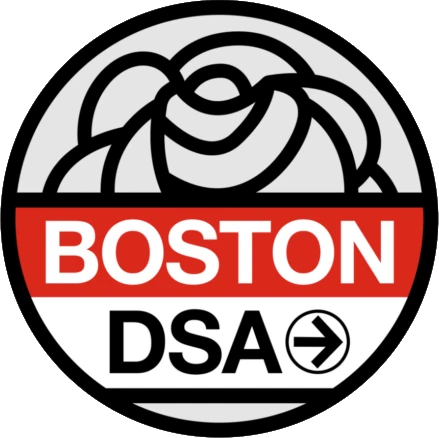

Step By Step, We Built a Movement to Transform Our Local Government
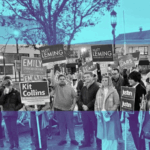
[[{“value”:”

By: Zac Bears and Jessica Farrell
This article was originally published in Convergence Magazine in 2024.
MEDFORD, MA – For decades, residents in Medford, Mass have voted many of the same people into office time and time again. City politics was, and in some ways still is, defined by long-standing conflicts between individual elected officials and their supporters. Political leadership roles were passed down to family members across multiple generations. Important proposals were approved or denied for who was supporting them just as often as they were for their merits. Facing the dual impact of incredibly restrictive state laws on municipal finance and lack of comprehensive planning and growth of the city’s tax base, Medford’s public infrastructure crumbled and the local government provided fewer city and school services.
After the Great Recession, the public schools cut dozens of positions, many of which never returned. Huge staff cuts in the Department of Public Works means the city outsources basic maintenance of streets and sidewalks. Many of our recreation, school sports, and arts programs are entirely funded by fees or managed by private nonprofits and donors.
All of this in a city where residents were voting for more progressive officials at the state and national level, where residents were seeing our neighboring communities improve far more rapidly, and where more residents were demanding the basic services, support for public schools, and the safe, well-maintained infrastructure they deserved.
These were, and still are, conditions where a movement for change can grow. Does this sound similar to your community? If so, the potential for change may be closer than you think.
Where We Live
Medford’s nearly 65,000 residents reside on both sides of the Mystic River five miles from Downtown Boston in a historically middle and working-class community. The city has one of the country’s oldest historically Black neighborhoods in West Medford, and a strong immigrant history with large Irish and Italian communities putting down roots here in the mid-20th century alongside fast-growing Haitian and Brazilian communities today.
Unlike neighbors in Cambridge, Somerville, and Everett, Medford has not grown a large commercial tax base to support city services or public schools and is largely dependent on residential property taxes to fund the city budget. Today, residents face skyrocketing housing costs and decades of underinvestment in streets, schools, and city staff. Hundreds of millions of dollars in deferred maintenance is now coming due, and because of Proposition 2.5, a 1980 MA ballot question that limited municipal property tax authority, high property values don’t equate to more tax revenue to fix these major problems.
Starting from the Bottom
Galvanized by the far-right victory in the 2016 national election, a small group of progressive residents founded Our Revolution Medford (ORM) in early 2017 to take action for progressive change at the local level. We developed our own local platform based on city issues, and while we occasionally share invitations and information for statewide and national Our Revolution events, the movement is entirely locally grown and directed and receives no outside funding. Eight years later, ORM has grown from a small backyard gathering to a citywide movement that elected majorities on both the Medford City Council and Medford School Committee.
Our initial conversations in 2017 quickly turned to the need for political analysis, desire to see candidates commit to real policies, and to fill in massive information gaps in a community with little-to-no local news media and scant public space for pre-election discussion and debate. We asked: who can we trust? Who can we influence? We brought together a group of people who could build trust and share the burden of paying attention to city government to help each other analyze what’s going on.
We reached out to lists of local residents we knew supported the Bernie Sanders campaign and movement, community organizations focused on change, and candidates for local office in the 2017 municipal election who seemed to share our values. Our initial membership was deeply intergenerational, from college students to retirees, and stretched across ideologies, including long-time local progressives, young socialists, frustrated parents, people facing housing displacement, and everyday folks who shared our values but didn’t choose a political label.
Three major strategic values soon followed from those meetings: (1) a clear focus on building power, (2) making the necessary preparations for successfully wielding power, and (3) growing our capacity through relationships and trust across the community.
Before 2017, many candidates for local office ran on city pride and local social and family connections. Their campaigns lacked specific policies or opinions on policy. Few discussed strategies to address major long-term fiscal and economic challenges. Our initial efforts to shift power were grounded in information-sharing and transparency, staking out clear policy positions and informing voters about what incumbent candidates believed and supported based on their votes and comments in Council meetings.
Strong support for progressive candidates like Bernie Sanders, Elizabeth Warren, and Ed Markey in our community showed us that the majority of residents wanted to see progress and transformative change. We decided early on that the best way to build power was to focus on organizing residents around city policy and government by creating grassroots policy campaigns and having a laser-focus on electing new members of the School Committee and City Council so that we could put those policies into place.
We decided early on that the best way to build power was to focus on organizing residents around city policy and government by creating grassroots policy campaigns and having a laser-focus on electing new members of the School Committee and City Council.
These two tactics took on specific forms. For grassroots policy campaigns, we held public events to educate residents about specific issues (for example, pushing to increase the low Payments in Lieu of Taxes or PILOTs from large tax-exempt institutions like Tufts University), discussed topics in ORM meetings, and held city council watch parties over a group chat. The chats help mobilize residents to reach out to elected officials and attend city meetings and connect residents’ everyday experiences to the actions of local government.
Our direct electoral work was even more focused and ambitious. Adapting a model successfully used in Richmond, CA and popularized by the Incorruptibles, we ran a “candidate slate” to help us overcome the financial and structural barriers progressive candidates face.
In Fall 2017, we formed a slapshot slate of candidates who were already running, pitched in personal funds to get some palm cards printed, canvassed a couple of times, and then stood at the polls on Election Day. Four of five of our endorsed candidates won, including one whose narrow majority survived a recount. This showed us that every single vote really mattered and gave us a wedge to grow in the subsequent years. Start small – with discipline and building a culture of organizing, there’s always room to grow.
Building Cycles of Organizing
Each win built on the ones before, with three School Committee Members and two City Councilors winning in 2019 (one of whom is Zac Bears, co-author of this article and ORM’s first member-turned-candidate), and eight out of nine endorsed candidates winning in 2021, including the first Asian-American person to serve on the Council, and securing majorities on both the City Council and the School Committee. Opponents who didn’t see us coming were surprised. Ten of 11 endorsed candidates won in 2023, including six of the seven who ran for Council seats. Several ORM-endorsed candidates won more than 50% of the vote, a rarity in the past even for long-time incumbents, and the top vote-getters for both Council and School Committee received more votes than the re-elected incumbent Mayor and the most votes for either office in at least 20 years.
While the idea of the platform and slate began with the Richmond Progressive Alliance model, we have greatly expanded it over the past six years. Each election cycle, we conduct an extensive community outreach and editing process to revise the Medford People’s Platform (MPP) and update the endorsement process we launched in 2019. We reach out to dozens of community organizations and major stakeholders, engaging hundreds of residents with surveys and public forums. We hold community workshops on the questions of who is included in decision-making, what are our core values, and what policies we want to see implemented in our city.
The result? A platform that we all agree to work towards, even though most members do not agree 100% with every point. Each successive election, we have expanded the process, engaging more residents and updating the platform to address changing conditions and celebrate hard-won victories. Candidates endorsed by Our Revolution Medford commit to support the platform; the platform shapes messaging and outreach for our coordinated electoral campaigns and provides the basis for a clear understanding of success and accountability after candidates win.
Now in its third iteration, the 2023-2024 Medford People’s Platform is focused on housing justice, racial justice, public health, and a shared vision for a welcoming, vibrant, and forward-looking local government that provides residents with the city and school services they deserve. The two biggest priorities are raising revenue to invest in a new Medford High School and Fire Headquarters and implementing transformative housing production, zoning reform, and economic development plans to fight housing displacement, grow the city’s commercial tax base, and build more vibrant local business and cultural districts.
Our work is purposeful and committed but joyful as well. We have consistently placed a high value on community-building. During each local election cycle, we grow the movement by building stronger relationships and growing our capacity to organize. Each non-election year, we sustain that movement-building through virtual city meeting watches and discussion spaces, and we hold regular general meetings. We focus on city government actions to hold elected officials accountable while supporting the good work done, and we hold social events to be in community with each other.
Historic Challenges
Inauguration day in January 2020 was a celebration of our successes. The months that followed showed the limits of our power, and then the limits of government and society. The COVID-19 pandemic struck Massachusetts and Medford hard. After just two months of Council meetings, we were in lockdown and dozens of Medford residents were getting seriously ill and dying, especially in our senior housing facilities. Shock pervaded the community, with highways and skies quieter than anyone had ever experienced. But in less than a month, Medford was able to implement videoconferencing for public meetings and the City Council began to meet again.
ORM-endorsed elected officials pushed hard for state and federal support, implementation of strong pandemic responses to protect residents from serious illness and death, resources and training for online learning to minimize the unimaginable disruption of the pandemic on kids, protection for residents facing housing displacement, and provisions for public meetings to continue to occur in a safe manner.
From 2017 to 2021, serving in the minority or with a slim majority meant we needed to build coalitions and consensus within the City Council and School Committee, and many of our more ambitious and long-overdue policy proposals were stymied before reaching passage or rejected as too ambitious by the mayor or city and school administrators who hold outsized power compared to the elected legislative bodies under our city charter.
With many progressives now in elected office, we see conflicts between people fighting to maintain the status quo and people who want to see the city grow and change play out constantly, with persistent arguments that people who have lived here across decades and generations and those who own property have more of a right to the city than residents who arrived more recently or who rent.
Transformation is in the Details
The progressive majority elected in 2023 has brought a major change in the tone and approach of the City Council. For the first time ever, the Council has created, voted on, and published a governing agenda for the 2024-2025 term that outlines major initiatives. A new Council committee structure helps clarify when and how the Council develops ordinances and conducts administrative oversight. Meeting agendas, schedules, and files are published through a new online portal. Updated Council rules contain a table of contents, guarantee remote participation by members of the public through hybrid meetings, and no longer contain arcane language to make the rules clearer and more accessible to the public.
Transformative initiatives and ordinances are moving quickly, with the Council voting to create an independent Department of Elections, passing the first Zoning Ordinance Recodification in 60 years, as well as passing ordinances updating snow removal policies to improve sidewalk access, several environmental and civil liberties ordinances, and a new budget ordinance that formally establishes an open and transparent budget process as city law.
We’ve also faced new, unexpected barriers. Our budget cycles lay bare the major short-term and long-term budget crisis facing Medford. Prior to 2023, budget cycles had a similar rhythm. Mayors would submit a proposed budget close to the June 30th deadline, some years riddled with errors. Councilors would demand accountability and attempt to set the facts straight during budget hearings held with less than ideal information to make decisions. Councils would attempt to hold strong and often would win small improvements, but year after year, residents would see service cuts to city departments and Medford Public Schools.
In FY24, the Council once again had serious concerns about the use of one-time federal funds for permanent operating budget positions as well as the lack of a long-term plan to fund the giant liabilities the city faces for school buildings, city facilities, streets, sidewalks, and our water and sewer infrastructure. While a budget plan released by Councilor Bears and supported by Councilors Collins and Tseng did not move forward in its entirety, major pieces were secured by an agreement reached between Mayor Breanna Lungo-Koehn, Council President Nicole Morell, and Councilor Bears and ratified by a June 2024 Council vote to approve the Mayor’s budget.
Since then, the City Council passed the city’s first-ever budget ordinance and in collaboration with the Mayor and School Committee leadership placed three referendum questions on the November 5, 2024 election ballot to raise revenue for the first time in the city’s post-Proposition 2.5 history. If voters approve these anti-austerity ballot questions, they would enable the city to raise revenue necessary to increase funding for the Medford Public Schools, build a new Fire Headquarters, and fund an in-house sidewalk and pothole repair crew in our Department of Public Works.
Planting Seeds of Change in Your Community
You are reading an unfinished story. We have won great victories by bringing together residents in a collaborative, joyful, and values-based political movement, and we also understand that single victories will not automatically create the positive change we want to see in our community.
We hope our model can help you build the progressive community you want for yourself, your family, your neighbors, and your friends. Please don’t hesitate to be in touch with us so we can fill in the gaps and help you learn more about what we’ve built here in Medford.
Zac Bears is a lifelong resident of Medford, MA and a graduate of the Medford Public Schools and UMass Amherst. Public education and the labor movement have been the foundation of Zac’s life–including transformative experiences as a student activist and opinion journalist at UMass Amherst, director of the Public Higher Education Network of Massachusetts (PHENOM), and as a member of AFGE, union staffer at AFSCME, and staff member at Massachusetts Jobs With Justice. Zac has been a Medford City Councilor since 2020 with a key focus on funding public services and supporting working families.
Jessica Farrell is an organizer and archivist. She worked in libraries, archives, and nonprofits for 15 years. Since 2024 she has owned and operated Redstart Works, consulting on library and archives projects that expand the commons. Her commitment to free access to information compels her to fill civic information and data gaps in her communities. Her commitment to the commons compels her to advocate for the expansion and funding of social services, including libraries.
The post Step By Step, We Built a Movement to Transform Our Local Government appeared first on Working Mass.
“}]]